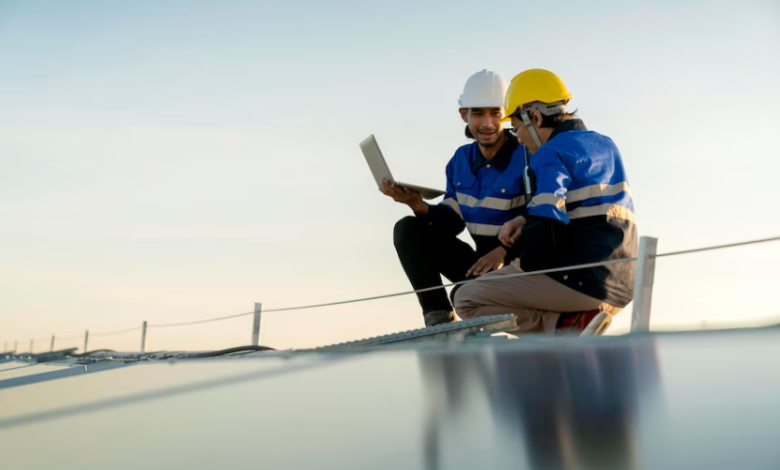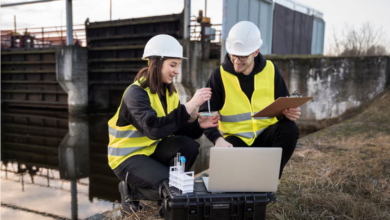Top Trends in Commercial Roofing Austin: What to Expect in 2025

Table of Contents
Sustainable Roofing Solutions
Sustainability is becoming a huge deal in commercial roofing Austin. Everyone’s looking for ways to reduce their environmental impact, and roofing is no exception. In 2025, expect to see even more focus on eco-friendly options for capital city roofing.
Green Roof Installations
Green roofs, also known as living roofs, are gaining popularity. These roofs are covered with vegetation and a growing medium, installed over a waterproofing membrane. They offer several benefits:
- Reduced stormwater runoff
- Improved insulation, leading to lower energy costs
- Creation of green spaces in urban environments
- Enhanced air quality
Green roofs can be more expensive to install initially, but the long-term benefits often outweigh the costs. They require regular maintenance, including watering, weeding, and fertilization, to keep the vegetation healthy.
Recyclable Roofing Materials
Using recyclable materials is another key trend. Many roofing manufacturers are now producing materials from recycled content, such as metal, plastic, and rubber. These materials reduce waste and conserve natural resources. Metal roof Austin is a great example of a recyclable material that is also durable and long-lasting. Choosing recyclable options helps businesses meet their sustainability goals and reduce their environmental footprint.
Energy-Efficient Systems
Energy-efficient roofing systems are designed to reduce energy consumption and lower utility bills. These systems often incorporate features such as:
- Reflective coatings that reduce heat absorption
- Insulation to minimize heat transfer
- Cool roofing materials that stay cooler in the sun
Energy-efficient roofing can significantly reduce a building’s carbon footprint and save money on energy costs over the long term.
Here’s a simple comparison of different roofing materials and their energy efficiency:
| Material | Reflectivity | Insulation | Cost |
| Asphalt Shingles | Low | Moderate | Moderate |
| Metal Roofing | High | Moderate | High |
| Green Roofing | Very High | High | Very High |
Technological Advancements in Roofing
Technology is changing everything, and commercial roofing Austin is no exception. By 2025, expect even more tech integration, making roofing projects more efficient and roofs themselves smarter.
Drones for Roof Inspections
Drones are already making waves, but their use will be even more widespread. Forget manual inspections; drones equipped with high-resolution cameras and thermal imaging can quickly identify leaks, damage, and potential problems. This saves time and money, and it’s safer for inspectors. For capital city roofing, this means faster turnaround times and more accurate assessments.
- Faster inspections
- Reduced risk for workers
- More detailed reports
Smart Roofing Systems
Smart roofs are the future. These systems use sensors to monitor temperature, moisture, and other environmental factors. This data can be used to optimize energy efficiency, predict maintenance needs, and even detect leaks before they cause major damage. Imagine a metal roof Austin that tells you when it needs attention!
Smart roofing systems are not just about convenience; they’re about proactive management. By monitoring conditions in real-time, building owners can prevent costly repairs and extend the lifespan of their roofs.
3D Printing in Roofing
3D printing is still in its early stages for roofing, but the potential is huge. Imagine printing custom roofing components on-site, reducing waste and speeding up construction. While widespread adoption is still a few years away, expect to see pilot projects and increased research in this area. This could revolutionize how commercial roofing Austin is done.
| Feature | Current Status | 2025 Prediction | Future Potential |
| Custom Components | Limited | Pilot Projects | Widespread Use |
| Material Options | Limited | Expanding | Diverse |
| Speed | Slow | Improving | Fast |
3D printing could drastically change the way we approach roofing projects.
Regulatory Changes Impacting Roofing
New Building Codes
Building codes are always changing, and that’s especially true for commercial roofing Austin. In 2025, expect even stricter requirements for things like wind resistance, fire safety, and energy efficiency. This means capital city roofing projects will need to be designed and installed with these updated codes in mind from the get-go. It’s not just about slapping on a roof anymore; it’s about making sure it meets all the latest standards. This can add to the initial cost, but it’s an investment in safety and long-term performance.
Environmental Regulations
Environmental regulations are becoming a bigger deal in the roofing industry. There’s a growing push for sustainable practices, and that includes what materials are used and how they’re disposed of. Expect more focus on recyclable roofing materials and methods to reduce waste. For example, some regulations might encourage the use of cool roofing options to combat the urban heat island effect. Also, proper disposal of old roofing materials is under scrutiny, with more emphasis on recycling and reducing landfill waste. This is especially relevant for metal roof Austin projects, where recycling is often a viable option.
Safety Standards Updates
Safety is always a top priority, and roofing is no exception. Expect updates to safety standards that impact how roofing work is done. This could include new requirements for fall protection, equipment operation, and worker training. These updates are designed to reduce accidents and injuries on the job site. While these changes might add to the cost of a project, they’re essential for protecting workers and ensuring a safe working environment.
Staying up-to-date with these regulatory changes is crucial for any commercial roofing project. Ignoring these updates can lead to costly delays, fines, or even legal issues. It’s important to work with a roofing contractor who is knowledgeable about the latest regulations and can ensure that your project complies with all applicable requirements.
Innovative Roofing Materials
The world of commercial roofing is always changing, and the materials we use are no exception. In Austin, especially, with its crazy weather, having the right roof can make a huge difference. Let’s look at some of the innovative materials that are becoming more common in commercial roofing austin.
Cool Roofing Options
Cool roofs are designed to reflect sunlight and absorb less heat than standard roofs. This can significantly reduce energy consumption, especially during those scorching Austin summers. They’re not just about saving money on AC bills, though; they also help reduce the urban heat island effect, making the capital city roofing more comfortable overall. There are different types of cool roofs, including reflective coatings, tiles, and membranes. Choosing the right one depends on the building’s structure and the specific needs of the business.
Reflective Coatings
Reflective coatings are a popular choice for existing roofs because they’re relatively easy to apply and can dramatically improve a roof’s reflectivity. These coatings are typically made from materials like acrylic or polyurethane and can be applied to various roofing surfaces, including metal, asphalt, and concrete. They work by reflecting a large portion of the sun’s rays away from the building, which helps to keep the interior cooler. This is especially important for commercial buildings with large roof areas, as they tend to absorb a lot of heat. Reflective coatings can also extend the lifespan of a roof by protecting it from UV damage and thermal stress. For businesses looking for a cost-effective way to improve energy efficiency, reflective coatings are a solid option.
Durable Synthetic Materials
Synthetic roofing materials are engineered to withstand the elements and offer long-lasting performance. These materials often mimic the look of traditional roofing materials like slate or wood but are much lighter and more durable. They’re resistant to cracking, fading, and rotting, making them a great choice for commercial buildings that need a roof that can stand up to the test of time. Plus, many synthetic roofing materials are made from recycled content, which makes them an environmentally friendly option. For example, some synthetic shingles are made from recycled plastic or rubber, which helps to reduce waste and conserve resources. When considering a new roof, it’s worth exploring the possibilities of durable synthetic materials.
Choosing the right roofing material is a big decision. Consider factors like cost, durability, energy efficiency, and aesthetics. Talk to a qualified roofing contractor to get expert advice and ensure that your new roof meets your specific needs.
Here’s a quick comparison of some innovative roofing materials:
| Material | Pros | Cons |
| Cool Roof Coatings | Energy efficient, reduces heat island effect, extends roof lifespan | Can be more expensive upfront, requires proper application |
| Synthetic Materials | Durable, lightweight, eco-friendly, mimics traditional materials | Can be more expensive than traditional materials, may require specialized installation |
| Metal Roof Austin | Long-lasting, fire-resistant, energy efficient | Can be noisy during rain, may require specialized installation, costlier |
- Consider the climate.
- Think about the building’s design.
- Factor in your budget.
Market Demand and Economic Factors
Impact of Local Economy
The Austin economy is a big deal when it comes to commercial roofing. When businesses are doing well, they’re more likely to invest in new buildings or upgrade their existing ones, which means more work for commercial roofing Austin companies. If the economy slows down, projects might get delayed or canceled. It’s all connected. The growth in Austin has been pretty wild, and that’s kept capital city roofing companies busy. But things can change fast, so everyone’s watching the economic indicators closely.
Commercial Real Estate Trends
Commercial real estate trends directly influence the roofing market. Are new office buildings going up? Are warehouses expanding? These projects need roofs! The type of construction also matters. High-end office spaces might call for premium roofing materials, while a basic warehouse might go for something more cost-effective. The shift towards more sustainable building practices is also impacting material choices. It’s not just about putting a roof on; it’s about doing it in a way that aligns with current real estate trends.
Insurance and Financing Changes
Insurance and financing play a huge role in what roofing projects get the green light. If insurance companies start requiring more stringent roofing standards to cover damage claims, that can drive up the demand for better, more durable roofing systems. Similarly, if it becomes harder for businesses to get financing for construction or renovation projects, that can slow down the market. Interest rates, loan availability, and insurance regulations are all factors that roofing contractors in Austin have to keep an eye on. For example, a metal roof Austin might have different insurance implications than a traditional asphalt roof.
Changes in insurance policies can significantly affect the types of roofing materials businesses choose. Higher premiums for less durable materials might push owners towards more expensive but longer-lasting options.
Here’s a quick look at how financing can impact roofing decisions:
- Loan Availability: Easier access to loans means more projects.
- Interest Rates: Lower rates encourage investment.
- Insurance Requirements: Stricter rules can drive up material costs.
Aesthetic Trends in Commercial Roofing
Commercial roofing Austin is seeing some interesting shifts in what looks good. It’s not just about function anymore; businesses want their roofs to make a statement. Capital city roofing projects are increasingly incorporating design elements that reflect the brand and enhance the overall building aesthetic. Let’s take a look at what’s trending.
Architectural Styles
We’re seeing a move away from purely utilitarian roofs. More businesses are opting for designs that complement the building’s architecture. This could mean anything from incorporating curves and angles to using materials that mimic traditional roofing styles. For example, a modern office building might use a sleek, flat roof with hidden drainage, while a renovated historic building might opt for a metal roof Austin that resembles classic standing seam roofing.
Color Trends
Color is playing a bigger role in commercial roofing. While neutral colors like gray and black are still popular, we’re seeing more businesses experiment with bolder hues.
- Light colors can help reflect sunlight and reduce energy costs.
- Darker colors can add a touch of sophistication and blend in with the surrounding environment.
- Accent colors can be used to highlight specific architectural features.
Integration with Building Design
Roofs are no longer being treated as separate entities. Instead, they’re being integrated into the overall building design. This means considering how the roof interacts with the walls, windows, and landscaping. For example, a building with a green roof might incorporate plants that cascade down the walls, creating a seamless transition between the roof and the rest of the structure.
Integrating the roof into the overall design is becoming increasingly important. It’s about creating a cohesive and visually appealing building that reflects the brand’s identity and values.
Maintenance and Longevity Practices
Preventative Maintenance Programs
Okay, so you’ve got a commercial roof in Austin. What’s next? Well, ignoring it isn’t an option. Preventative maintenance is key. Think of it like this: a little check-up now can save you from a major headache (and expense) later. For commercial roofing Austin, this is especially true with our crazy weather.
- Regular inspections are a must.
- Clear debris – leaves, branches, the usual suspects.
- Check for any signs of damage, no matter how small.
Roofing Life Cycle Management
It’s not just about fixing problems as they pop up; it’s about planning for the long haul. Understanding the life cycle of your roof is super important. Different materials have different lifespans, and knowing where you are in that cycle helps you budget and prepare for eventual replacement. “capital city roofing” companies can help you assess this.
Planning for the end of your roof’s life is just as important as the beginning. Consider factors like material degradation, environmental impact, and potential upgrades when making decisions about your roofing system. This proactive approach can save money and minimize disruptions in the long run.
Seasonal Maintenance Tips
Austin weather is… well, it’s Austin weather. Hot summers, occasional freezes, and everything in between. That means your roof needs different care depending on the season.
- In the spring, check for damage from winter storms.
- In the summer, look for signs of heat damage, especially on flat roofs.
- In the fall, clear leaves and debris before winter hits.
And don’t forget about your metal roof Austin! Metal roofs are durable, but they still need some love, especially after those intense summer storms. Regular inspections and cleaning can keep them in top shape for years to come.
Wrapping It Up
As we look ahead to 2025, the commercial roofing scene in Austin is shaping up to be pretty interesting. With more focus on sustainability and energy efficiency, businesses are likely to invest in greener options. Technology will also play a big role, making roofs smarter and easier to maintain. Plus, the demand for durable materials will keep rising as property owners want roofs that last. Overall, if you’re in the roofing game or just curious about it, keeping an eye on these trends will be key. The future looks bright, and it’s going to be exciting to see how things unfold.
Meta Description
Explore the top trends in commercial roofing Austin for 2025, from sustainability to innovative materials.




